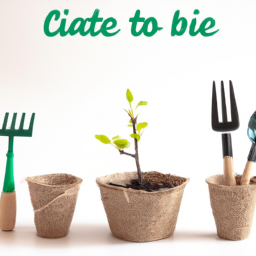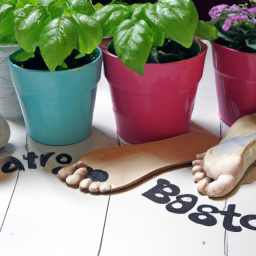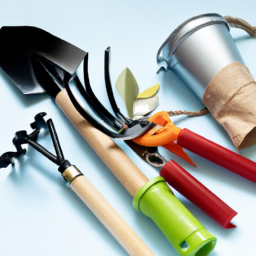
Are you an avid gardener looking to make your green thumb even greener? If so, you’ve come to the right place. In this blog post, we will explore the world of eco-friendly garden tools and delve into the importance of choosing sustainable equipment. With the increasing awareness of environmental issues, many gardeners are now opting for tools that are not only efficient but also eco-friendly. By using environmentally friendly tools, you can minimize your carbon footprint and contribute to a healthier planet. So, let’s dive in and discover how you can transform your garden into a sustainable oasis with the right equipment.
Benefits of Eco-Friendly Garden Tools: Reducing Environmental Impact
Introduction
Gardening is not only a rewarding hobby but also a way to connect with nature and contribute to a healthier environment. However, it’s important to be mindful of the tools we use in our gardens. Traditional gardening tools often have a negative impact on the environment due to their high carbon footprint and harmful manufacturing processes. In this article, we will explore the benefits of using eco-friendly garden tools and how they can help reduce our environmental impact.
1. Healthier Soil and Plants
One of the key benefits of eco-friendly garden tools is their ability to promote healthier soil and plants. Conventional gardening tools, such as gas-powered lawnmowers and leaf blowers, emit harmful pollutants into the air, leading to air pollution and soil degradation. On the other hand, eco-friendly tools, such as manual push mowers and hand rakes, have zero emissions and do not contribute to air pollution. By opting for these sustainable alternatives, you can create a healthier environment for your plants to thrive.
Additionally, eco-friendly garden tools are designed to be more gentle on the soil. Traditional tools like tillers and power hoes can disrupt the natural structure of the soil, leading to erosion and nutrient depletion. On the contrary, hand tools like trowels and hand forks allow for more precise and controlled work, minimizing soil disturbance and preserving its natural fertility. This, in turn, promotes healthier plant growth and reduces the need for chemical fertilizers.
In summary, eco-friendly garden tools contribute to healthier soil and plants by reducing air pollution, minimizing soil disruption, and promoting natural fertility.
2. Lower Carbon Footprint
Another significant advantage of eco-friendly garden tools is their lower carbon footprint compared to conventional tools. Traditional gardening equipment often relies on fossil fuels, such as gasoline and diesel, which release greenhouse gases when burned. These emissions contribute to climate change and its adverse effects on the environment.
Eco-friendly garden tools, on the other hand, are designed to be more energy-efficient and utilize renewable energy sources. For example, solar-powered garden lights and water pumps harness the sun’s energy, eliminating the need for electricity and reducing carbon emissions. Similarly, battery-powered tools, like cordless trimmers and hedge clippers, offer a greener alternative to their gas-powered counterparts.
By choosing eco-friendly tools, you can significantly reduce your carbon footprint and contribute to the fight against climate change. Every small step towards sustainability counts, and opting for sustainable garden equipment is a great way to make a positive impact.
3. Long-Term Cost Savings
While eco-friendly garden tools may require a higher initial investment compared to their conventional counterparts, they often offer long-term cost savings. Traditional tools that rely on fossil fuels can be expensive to operate and maintain. The cost of purchasing gasoline or diesel, as well as routine maintenance, can quickly add up over time.
Eco-friendly tools, on the other hand, typically have lower operating costs. Solar-powered garden lights, for instance, rely on free solar energy and do not require any additional expenses once installed. Battery-powered tools may require occasional battery replacements but are generally more cost-effective in the long run compared to constantly purchasing fuel.
Furthermore, eco-friendly garden tools often have a longer lifespan and require less frequent replacement. High-quality, durable materials are commonly used in their construction, making them more resistant to wear and tear. By investing in sustainable tools, you can save money in the long term and enjoy their benefits for years to come.
Conclusion
Choosing eco-friendly garden tools is a simple yet impactful way to reduce our environmental impact and create a more sustainable future. By promoting healthier soil and plants, lowering our carbon footprint, and offering long-term cost savings, these tools provide numerous benefits for both the environment and gardeners alike. So, let’s make a conscious choice to embrace eco-friendly gardening and contribute to a greener world.
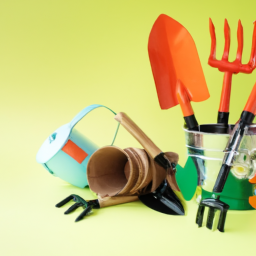
Factors to Consider When Choosing Sustainable Garden Tools
Gardening is not only a rewarding hobby but also an excellent way to contribute to a sustainable environment. By choosing eco-friendly garden tools, you can minimize the negative impact on the planet while still enjoying the beauty of your garden. In this guide, we will explore the key factors to consider when selecting sustainable equipment for your garden.
1. Material and Durability
When it comes to eco-friendly garden tools, the material they are made from plays a crucial role. Opting for tools made from sustainable materials such as bamboo, recycled plastic, or FSC-certified wood can significantly reduce your carbon footprint. These materials are renewable and have a lower environmental impact compared to traditional materials like metal or non-recycled plastic.
In addition to the material, durability is another important consideration. Look for tools that are built to last. Investing in high-quality, durable garden tools may require a slightly higher upfront cost, but it will save you money in the long run and reduce waste by minimizing the need for frequent replacements.
Furthermore, consider the maintenance requirements of the tools. Choose tools that are easy to clean and maintain, as this will extend their lifespan and ensure their sustainable use over time.
2. Energy Efficiency
Reducing energy consumption is an essential aspect of sustainability. When selecting garden tools, opt for those that are energy-efficient or manual. Electric or battery-powered tools may offer convenience, but they often require a significant amount of energy to operate. On the other hand, manual tools, such as hand pruners or manual lawnmowers, rely on human power and have zero energy consumption.
For tasks that require power tools, consider investing in rechargeable batteries or solar-powered options. These alternatives minimize the use of disposable batteries and utilize renewable energy sources, making them more sustainable choices for your garden.
Additionally, look for tools with energy-saving features such as adjustable power settings or automatic shut-off mechanisms. These features help optimize energy usage and reduce unnecessary waste.
3. Water Efficiency
Water is a precious resource, and using it efficiently is a key aspect of sustainable gardening. When choosing garden tools, consider their impact on water consumption.
For watering purposes, opt for tools like drip irrigation systems or soaker hoses, which deliver water directly to the roots of plants, minimizing evaporation and water waste. These tools help conserve water and promote healthier plant growth by ensuring efficient water distribution.
Furthermore, select tools that allow for rainwater harvesting. Rain barrels or rainwater collection systems can be used to capture and store rainwater, which can then be utilized for watering your garden. This reduces reliance on freshwater sources and conserves water resources.
Lastly, consider the design of the tools. Look for options that have adjustable spray patterns or flow control features. These allow you to customize the amount of water used based on the specific needs of your plants, preventing overwatering and water runoff.
By considering these factors when choosing your garden tools, you can make a positive impact on the environment while nurturing a beautiful and sustainable garden. Remember, sustainability is a journey, and every small step counts towards a greener future.

Top Eco-Friendly Garden Tools for Sustainable Gardening Practices
Gardening is not only a rewarding hobby but also an opportunity to contribute to a healthier planet. By choosing eco-friendly garden tools, you can reduce your environmental impact and promote sustainable gardening practices. In this guide, we will explore three top eco-friendly garden tools that can help you create a more sustainable garden.
The Benefits of Eco-Friendly Garden Tools
Before we dive into specific tools, let’s understand why eco-friendly garden tools are essential. Traditional gardening tools often contribute to environmental pollution and resource depletion. Many non-eco-friendly tools are made from materials like plastic and metal, which require significant energy and resources to manufacture.
On the other hand, eco-friendly garden tools are designed with sustainability in mind. They are typically made from renewable materials, such as bamboo or recycled plastic, and are often more durable and long-lasting. By choosing these tools, you can reduce waste, conserve resources, and minimize your carbon footprint.
Now, let’s explore the top three eco-friendly garden tools that can transform your gardening practices:
1. Bamboo Garden Tools
Bamboo garden tools are an excellent choice for eco-conscious gardeners. Bamboo is a fast-growing plant that requires minimal water and no pesticides to thrive. It is also incredibly strong and durable, making it an ideal material for garden tools.
When selecting bamboo garden tools, look for those made from sustainably harvested bamboo. Avoid tools with synthetic handles or coatings, as these may contain harmful chemicals. Bamboo garden tools are available in various types, including shovels, rakes, and hoes, so you can find the right tools for your gardening needs.
2. Recycled Plastic Garden Tools
Recycled plastic garden tools are another eco-friendly option to consider. These tools are made from recycled plastic materials, such as old water bottles or packaging, which helps reduce plastic waste in landfills or oceans.
When purchasing recycled plastic garden tools, ensure they are labeled as made from post-consumer recycled materials. These tools are often as durable as their non-recycled counterparts and can withstand various gardening tasks. Look for tools with ergonomic designs and comfortable grips to make your gardening experience more enjoyable.
3. Hand-Powered Garden Tools
Hand-powered garden tools are an excellent alternative to gas-powered or electric tools. They require no fuel or electricity to operate, reducing greenhouse gas emissions and noise pollution. These tools are perfect for small-scale gardening tasks and can be used in tight spaces or delicate areas.
Some popular hand-powered garden tools include hand pruners, shears, and weeders. Look for tools with sharp blades and sturdy construction to ensure efficient and effective gardening. Remember to maintain and sharpen these tools regularly to prolong their lifespan.
Conclusion
Choosing eco-friendly garden tools is a simple yet impactful step towards sustainable gardening practices. By opting for bamboo garden tools, recycled plastic tools, or hand-powered tools, you can reduce waste, conserve resources, and minimize your environmental footprint. Embrace these eco-friendly options and enjoy a greener and more sustainable garden!
In Summary
Are you a passionate gardener who wants to make a positive impact on the environment? If so, it’s time to consider using eco-friendly garden tools. In this blog post, we will explore the importance of choosing sustainable equipment for your gardening needs.
Traditional garden tools often contribute to pollution and waste, but eco-friendly alternatives can help minimize these negative effects. One option is to opt for hand tools made from sustainable materials such as bamboo or recycled plastic. These tools are not only durable but also biodegradable, ensuring that they won’t end up in landfills. Another eco-friendly choice is to invest in electric or battery-powered tools instead of gas-powered ones. These alternatives produce fewer emissions and are generally quieter, making them a more environmentally friendly option. By choosing sustainable garden tools, you can enjoy your gardening hobby while reducing your carbon footprint.
Here are some questions from our readers:
Q1: What are eco-friendly garden tools?
A1: Eco-friendly garden tools are equipment and supplies that are designed and manufactured with a focus on reducing their environmental impact. These tools are made from sustainable materials, use renewable energy sources, and minimize pollution and waste during production and use.
Q2: Why should I choose eco-friendly garden tools?
A2: By choosing eco-friendly garden tools, you contribute to the preservation of the environment and promote sustainable gardening practices. These tools are often more energy-efficient, produce fewer emissions, and have a smaller carbon footprint compared to conventional tools. Additionally, using eco-friendly tools can help create a healthier and more balanced ecosystem in your garden.
Q3: What are some examples of eco-friendly garden tools?
A3: There are various types of eco-friendly garden tools available. Some examples include hand tools made from sustainably sourced wood or recycled materials, solar-powered garden lights, water-saving irrigation systems, and electric or battery-powered lawn mowers and trimmers. These tools offer efficient alternatives to their traditional counterparts, reducing reliance on fossil fuels and minimizing environmental harm.
Q4: How can I identify eco-friendly garden tools?
A4: Look for certifications or labels indicating that a garden tool is eco-friendly or sustainable. Some common certifications to watch for include the Forest Stewardship Council (FSC) label for sustainably sourced wood, Energy Star certification for energy-efficient products, and the USDA Organic label for gardening supplies made from natural and non-toxic materials. Additionally, do some research and read product descriptions to learn about the manufacturer’s commitment to sustainability.
Q5: Where can I purchase eco-friendly garden tools?
A5: Eco-friendly garden tools can be found at various retailers, both online and in physical stores. Many gardening supply stores now offer a dedicated section for eco-friendly products. Additionally, you can explore online marketplaces that specialize in sustainable and environmentally friendly goods. Remember to check customer reviews and compare prices to ensure you’re getting the best quality tools for your needs.
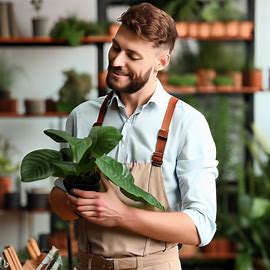
Alex Turner is a sustainable gardening advocate and the founder of an acclaimed indoor gardening blog. With a focus on eco-friendly practices and urban sustainability, Alex combines his background in environmental studies with his love for plants to educate readers on mindful indoor gardening. His work highlights the importance of nurturing both plants and the planet.

